February 2022 6
Extremely dangerous situation in Ukraine

Extremely dangerous situation in Ukraine
The territory of Ukraine is in an extremely dangerous situation, Kremlin spokesman Dmitry Peskov said, explaining that the army acts as terrorists because they install multiple rocket launchers in Kiev and Kharkov under the advice of foreign experts.
Translated and edited by Walter Lippmann for CubaNews.

Russian military presence in Ukraine. Photo: AP
The territory of Ukraine is in an extremely dangerous situation, Kremlin spokesman Dmitry Peskov called it, explaining that the military acts as terrorists because they install multiple rocket launchers in Kyiv and Kharkiv under the advice of foreign experts.
At this juncture, Vladimir Putin urged the Ukrainian military: “Do not allow neo-Nazis and ultra-nationalists to use your children, wives and old people as human shields, to take power into their hands. It seems that it will be easier to come to an agreement with you than with this gang of drug addicts and neo-Nazis who lodged in Kyiv and took the entire Ukrainian people hostage,” Russia Today quoted him as saying.
The head of state noted that the main fighting of the Russian Army is conducted, “not against regular units of the Armed Forces of Ukraine, but against nationalist formations, which, as is known, bear direct responsibility for the genocide in Donbass and the blood of civilian citizens of the people’s republics.”
He highlighted information that neo-Nazis are deploying heavy weapons in central areas of large cities, including Kyiv and Kharkiv, to provoke return fire from the Russian military against residential neighborhoods. “They act in the same way as terrorists all over the world: they hide behind people in the hope of blaming Russia for casualties among the civilian population,” Putin said.
Pope Francis visited the Russian Embassy to the Vatican to meet with the head of the diplomatic mission, Alexander Avdeev, to discuss the situation in Ukraine. The pontiff assured them that he is closely observing the development of events in Ukraine and expressed his concern about the escalation after the start of the military operation ordered on Thursday by Russian President Vladimir Putin.
Likewise, the presidents of Russia and China, Vladimir Putin and Xi Jinping, held a telephone conversation to discuss the Ukrainian crisis in a constructive and friendly atmosphere.
Xi stressed that he respects Russia’s actions in the crisis in the neighboring country and showed the coincidence of the positions of the two countries on the main issues of the international agenda, the Kremlin says in its statements.
Sanctions against Russia
The Council of Europe suspends Russia’s membership amid its military operation in Ukraine, a measure proposed by Poland and Ukraine that won the consensus of 42 of the committee’s 47 members.
Leaders of European Union countries agreed at an emergency summit to impose new economic sanctions against Moscow following the start of the military operation launched by Russia to defend Donbas.
European Commission President Ursula von der Leyen said that this second package of sanctions by the bloc will affect 70% of the banking market and Russia’s major state-owned enterprises, including those in the defense sector.
RT also highlighted the words of UK Foreign Secretary Liz Truss, who warned that London will continue to take action until the Russian economy is impaired and the integrity of Ukrainian territory is restored. “We will not rest until the Russian economy has been degraded and Ukraine’s sovereignty and territorial integrity have been restored,” the head of British diplomacy said.
Sputnik also noted the measures taken by Poland, which closed its airspace to Russian aircraft, while Switzerland banned financial transactions with 363 Russian individuals and four legal entities.
For his part, Russian Foreign Minister Sergei Lavrov accused NATO and the European Union of supporting Kiev in recent weeks, when it decided to seize by force the Donetsk People’s Republic and the Lugansk People’s Republic, in order to destroy the Minsk agreements. “The West fully supports the Kyiv regime in its efforts to sabotage and in the end destroy the Minsk Agreements,” Sputnik quoted Sputnik as saying.
However, no country in the transatlantic alliance wants to get involved in a war with Russia, according to statements by French Defense Minister Florence Parly and reminded that the Eurasian nation is a nuclear power.
MINREX: For international peace and security

Call for the preservation of international peace and security
Statement by the Ministry of Foreign Affairs
Author: MINREX | internet@granma.cu
Translated and edited by Walter Lippmann for CubaNews.
The United States’ endeavor to impose NATO’s progressive expansion towards the borders of the Russian Federation constitutes a threat to the national security of the Russian Federation and to regional and international peace.
The U.S. Government has for weeks been threatening Russia and manipulating the international community about the dangers of an “imminent massive invasion” of Ukraine. It has supplied weapons and military technology, deployed troops in several countries in the region, applied unilateral and unjust sanctions, and threatened other reprisals. At the same time, it has unleashed an anti-Russian propaganda campaign.
Cuba has previously warned about the danger of this policy.
On February 22, 2014, the then President of the Councils of State and Ministers, Army General Raul Castro Ruz, warned, “Right now, alarming events are taking place in Ukraine. The intervention of Western powers must cease (…). It should not be ignored that these events could have very serious consequences for international peace and security”.
Years later, on September 26, 2018, before the United Nations General Assembly, the President of the Republic, Miguel Díaz-Canel Bermúdez, warned that, “The continued expansion of NATO towards the borders with Russia causes serious dangers, aggravated by the imposition of arbitrary sanctions that we reject.
We call on the United States and NATO to seriously and realistically address the well-founded demands for security guarantees from the Russian Federation, which has the right to defend itself.
Cuba advocates a diplomatic solution through constructive and respectful dialogue.
We call for the preservation of international peace and security.
Ministry of Foreign Affairs of the Republic of Cuba
Havana, 22 February 2022
The Truth About Batista

The Truth About Batista
He was a pawn who implemented the policies for the region, advised by his mentors. His masters provided him with solid material support and military advice.
Translated and edited by Walter Lippmann for CubaNews.
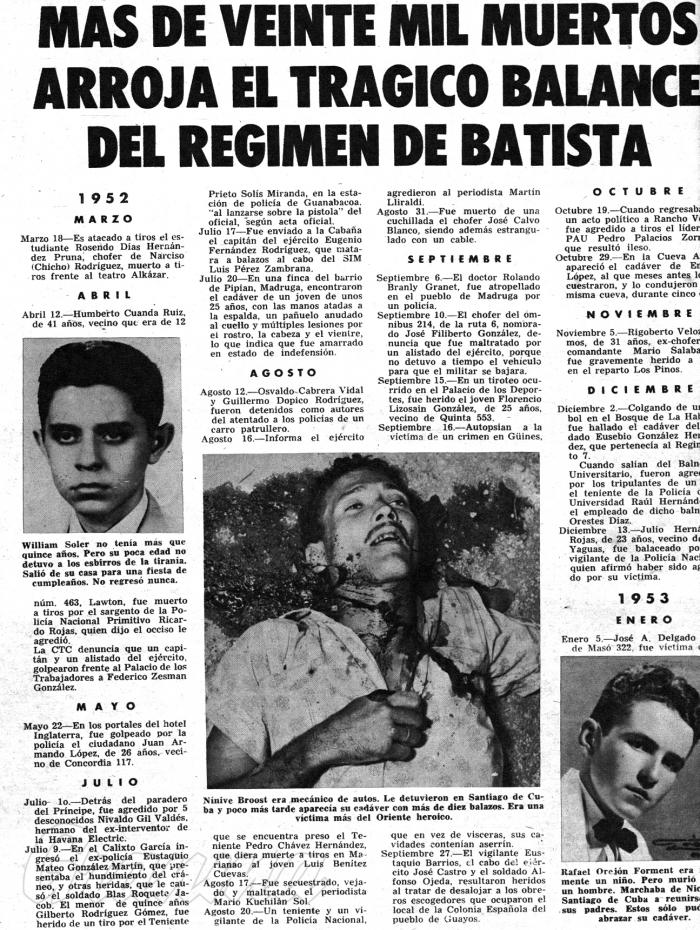
Page from Bohemia magazine, January 11, 1959 issue. Granma Archive
Lie, lie and lie some more. This is the line of the anti-Cuban media in South Florida, when dealing with the subject of the Island, in terms of current affairs, but also of the past.
For years, television networks, radio stations, websites and newspapers based there have, among their discursive guidelines -although the matrix has intensified notably during the last few weeks-, the vindication of the bloodthirsty tyrant Fulgencio Batista.
Throughout January and February 2022, there was a congestion of articles, comments and interviews with relatives of the dictator or alleged experts on his “legacy”. What has been said in such spaces about this terrifying character in Cuba’s history is so absurd and mendacious that it borders on delirium.
Any saint’s life would be dwarfed by such an avalanche of falsehoods aimed at ennobling the abject figure. But to really know who Fulgencio Batista was, it is not even necessary to go to “the history written by the communists”. The truth can even be found in the Western media, books and statements by high-ranking officials in Washington.
In 1952, this gentleman established the bloodiest and most corrupt dictatorship ever known in Cuba, with only the precedent of Gerardo Machado’s satrapy in terms of a criminal record.
Known for his previous work at the helm of the country, both because of his past as a coup leader and his pro-Washington fervors -demonstrated since his alliance with Ambassador Sumner Welles in 1933-, the 1952 uprising had the full backing of the U.S. Government.
He was a pawn who implemented the policies for the region, advised by his mentors. His masters gave him solid material backing and military advice, similar to what they did, years later, with the Pinochet misrule in Chile, after the coup against Salvador Allende.
U.S. investments would reach one billion dollars in Cuba throughout his term of office. The visits of then Vice President Richard Nixon and Allan Dulles, director of the CIA, in 1955, served to strengthen the empire’s economic and ideological programs on the island.
Dulles told the tyrant of his government’s concern about communist activity in Cuba, in response to which the dictator inaugurated, in a few weeks, the Bureau for the Repression of Communist Activities (the dreaded BRAC).
The “creature”, together with the no less dreadful Military Intelligence Service (SIM), the National Police and the Army, turned the country into a police state, in whose vortex people lived in permanent anxiety and where political disaffection was punished with death, without half measures.
Meanwhile, the U.S. mafia turned the night and gambling business into another empire in Cuba, called “the brothel of America”, a subject on which valuable research has been published.
Everyone in the north, bandits included, Batista had a free bar here. Thus, he sponsored the great assassins of Latin American history (Conrado Carratalá, Pilar García, the Salas Cañizares brothers -Rafael, Juan and José María- and Esteban Ventura Novo) and cohorts of criminals to defend his sinister political structure.
They were “men of base instincts, born criminals, beasts carrying all the ancestral atavisms dressed in human form”, to put it in Fidel’s words, who put the nation on edge and, especially, its youth, who died with their eyes gouged out, without nails, their testicles burst or raped, in barracks, ditches, wastelands, rivers, seas.
In his reign of “blood and plunder” -terms used by journalist Enrique de la Osa-, corruption surpassed all historical standards of a nation already expert in the matter. Batista, by himself, raised his presidential salary from 26,400 to 144,000 dollars, even higher than that of U.S. President Truman, whose salary was around 100,000 dollars.
However, a large part of the Cuban population was unemployed, while the majority of the peasants lived in huts with guano roofs [guano is the excrement of seabirds and bats] and dirt floors, with no sanitary services or running water. Meanwhile, 90% had no electricity.
As the French professor, Salim Lamrani states in his essay 50 truths about the Fulgencio Batista dictatorship in Cuba, the English economist Dudley Seers wrote that the situation in 1958 was intolerable: “in the countryside, social conditions were appalling. About a third of the nation lived in squalor (…) living in barracks, usually without electricity or latrines, victims of parasitic diseases and did not benefit from a health service.
“They were denied education (their children went to school for a year at the most). The situation of the precarious, installed in temporary shacks on collective lands, was particularly difficult (…). A significant proportion of the urban population was also very miserable”.
Arthur M. Schlesinger, Jr., personal advisor to President John F. Kennedy, wrote: “I loved Havana and was horrified by the way this lovely city was unfortunately transformed into a great casino and whorehouse for American businessmen (…). One wondered how Cubans – seeing this reality – could regard the U.S. in any other way than with hatred”.
This was the Cuba of misery, blood and terror imposed by Batista, the “beatific” president they now want to sell us from Florida. Just the thought of such a past redoubles our strength in the struggle to never go back to such a desolate scenario.
Ukraine and the spark of Donbass

Ukraine and the spark of Donbass
In a tweet, the member of the Political Bureau and Cuban Foreign Minister, Bruno Rodríguez Parrilla, wrote: “We strongly reject the propagandistic and communicational hysteria unleashed by the U.S. government against Russia and we firmly oppose the expansion of NATO to the borders of that brother country”.
Translated and edited by Walter Lippmann for CubaNews.
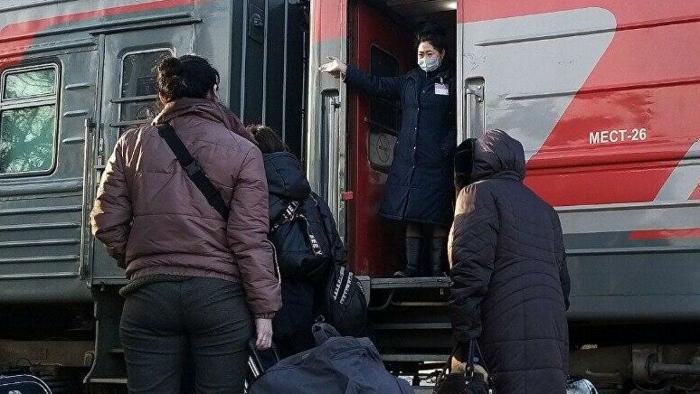
Russia estimates that more than 40 000 refugees from Donbas are already on its territory. Photo: Sputnik
The last week – that of the Russian “invasion” of Ukraine, fabricated by Washington – ended, and with it even the Russian military maneuvers, scheduled in advance, began the timeline for the return home of those involved.
Both the President of the United States, Joe Biden, as well as the highest exponents of NATO and some European rulers or subordinates were left wanting the shots to ring out and insisted on new lies on the same subject, but now more towards the inside of Ukraine than in the foreign environment.
The Kyiv government, used as “bait” for Russia to “take the bait” of the West and provoke a war, seems to be disappointed by so many lies and manipulation of those who have promised it NATO membership and the guarantee of its security in the face of a possible reaction from Moscow.
However, with these actions, the only thing they have caused Ukraine is a substantial economic loss that already exceeds $3 billion, without counting the bills that will be passed on later for the “aid” in weapons of all kinds that they are providing it with. But where are the shots and the supposed casualties caused by the Russian invasion? Where did the tanks and artillery that Washington announced would reach Kyiv come in.
Then they remembered a key piece in this puzzle: the separatist republics of Donbass with their territories of Donetsk (DPR) and Lugansk (LPR), in Ukraine, became, overnight, the spark of a new provocation against Moscow.
Kyiv, with its army, is staging a montage that cannot be sustained, but which already this weekend left some civilians dead and more than 40,000 people of Russian origin were forced to cross the border and take refuge in the Russian region of Rostov.
In view of the heated warlike mood, both Russia and Belarus, which had already ended their joint military maneuvers, have decided to prolong them. Belarusian Defense Minister Viktor Khrenin described the current scenario as “a strong smell of gunpowder” in the region, with the possibility of “Europe being pushed into a war”, as several neighboring countries are accumulating more advanced weapons, according to RT.
He also reiterated that the goal of the Russian and Belarusian maneuvers remains the same: “to ensure an adequate response and de-escalation of the enemies’ military preparations.”
In the meantime, the spark in Donbas may become, with the help of the West and the mainstream press at its service, a detonator that will make what Russia and the international community want to avoid – a war – a reality.
Carlos Lazo: I embraced Max Lesnik

Carlos Lazo: I embraced Max Lesnik knowing that he is a precursor of these #PuentesDeAmor.
I return to deliver my column to Carlos Lazo. Now with a more than deserved tribute to Max Lesnik, the legendary revolutionary of a thousand anecdotes who, from Cuba, in the United States and other corners of the world has written stories full of patriotism and humanism. Lazo, the president of Bridges of Love portrays him masterfully. HONOR TO WHOM HONOR IS DUE
By Carlos Rafael Dieguez
February 02, 2022
Photos by Michell Casanova
Translated and edited by Walter Lippmann for CubaNews.
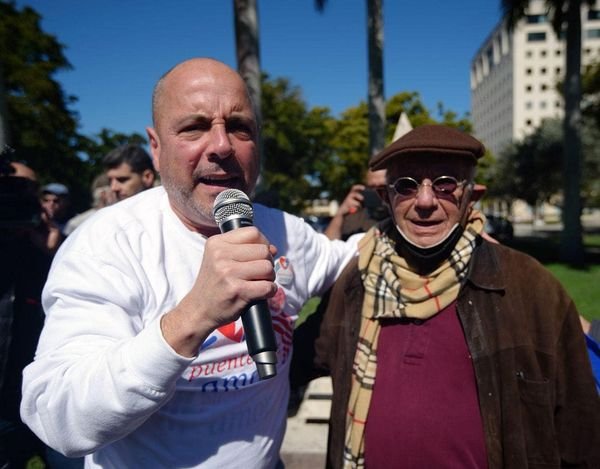 Max Lesnik is one of my heroes. A good Cuban, a good father, a good husband, a good friend. The other day I met him again in the Miami Caravan, raising his voice against the blockade. So old and yet so young, Max! I felt that his smile bore the accumulated joy of many decades, the same as when he was just a young boy and participated in the student struggles at the University of Havana against Batista’s tyranny.
Max Lesnik is one of my heroes. A good Cuban, a good father, a good husband, a good friend. The other day I met him again in the Miami Caravan, raising his voice against the blockade. So old and yet so young, Max! I felt that his smile bore the accumulated joy of many decades, the same as when he was just a young boy and participated in the student struggles at the University of Havana against Batista’s tyranny.
He hugged me and I felt again the great pride of sharing History, in capital letters and alive. In his eyes, I perceived the same stoicism, the same rebelliousness and transparency that he showed in 1960, when he left Cuba because he disagreed with the direction the Revolution was taking. Max has always been an honest man, without mincing his words.
Many years after that departure, his friend Fidel Castro would ask him, “Why did you leave?”. Max replied. “I didn’t like that Cuba was aligned with the Soviet Union.”
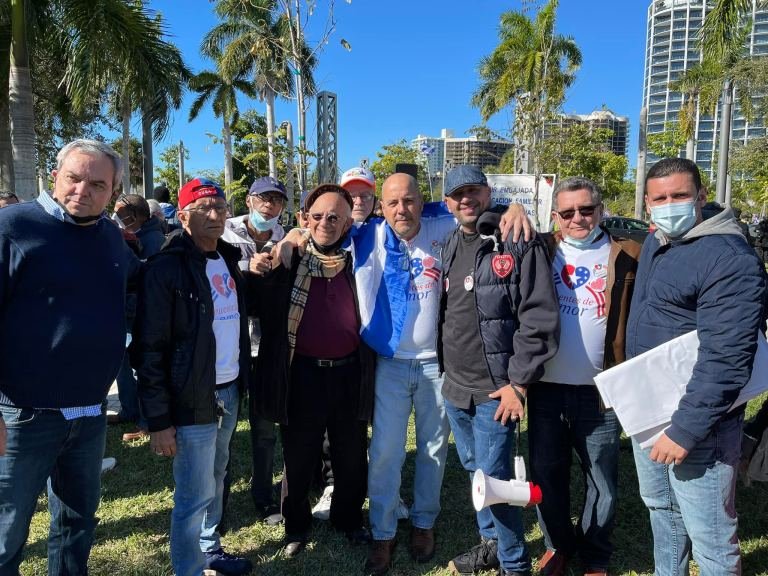 It is a privilege to be able to thank a man like him, a 90-year-old giant who is still in battle, coherent. The same Max who founded Réplica magazine in Miami. The “man of the two Havanas” -the “small” one in Miami and the big one on the island. The same Max who, in the United States, survived numerous terrorist attacks in an attempt to assassinate him, silence his message and overthrow his struggle. In him, always the same obsession: Cuba, Cuba, Cuba! Then and now.
It is a privilege to be able to thank a man like him, a 90-year-old giant who is still in battle, coherent. The same Max who founded Réplica magazine in Miami. The “man of the two Havanas” -the “small” one in Miami and the big one on the island. The same Max who, in the United States, survived numerous terrorist attacks in an attempt to assassinate him, silence his message and overthrow his struggle. In him, always the same obsession: Cuba, Cuba, Cuba! Then and now.
This Sunday I embraced the founder of the Alianza Martiana. Decades ago, in the United States, Max Lesnik and others founded that organization of diverse women and men. Since then, they dreamed of “a better relationship between the U.S. government and the peoples of Our America”. They opposed the blockade. In the Alianza, no one is rejected or discriminated against for reasons of creed, “race or political philosophy”. I embraced him knowing that he is a precursor of these #PuentesDeAmor through which we travel today and in which Max goes, ahead, removing weeds, opening possibilities, bringing Cubans together.
Max radiates that light carried by those who never stop fighting.
Carlos Lazo
February 2, 2022
Cuba: zero tolerance for drug trafficking

Cuba: zero tolerance for global drug trafficking threat
Permanent vigilance and timely response by specialized forces made it possible to dismantle a criminal network organized by Cubans from Mexico.
Translated and edited by Walter Lippmann for CubaNews.
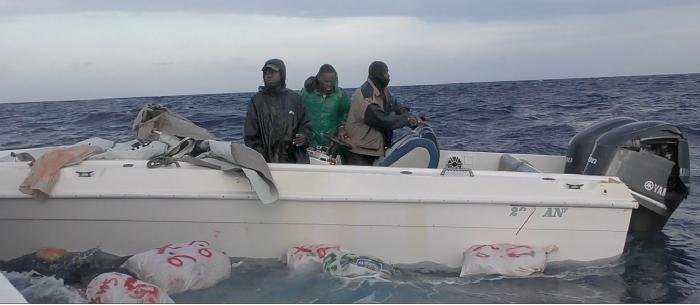
While the world is plunged into the devastating pandemic of COVID-19, hundreds of new and increasingly dangerous synthetic drugs are invading every corner of the planet, adding to the abuse of marijuana, cocaine and heroin, which affect almost 300 million people.
The main market on the planet, the United States, has the highest number of deaths from drug overdoses in its history, with more than 100,000 deaths between April 2020 and the same month in 2021, most of them due to the so-called opioid epidemic, which increased lethality by 28.5%.
Illicit drug trafficking and consumption continue to be a serious global phenomenon that threatens international security and from which no country can escape, due to the complex and sophisticated networks of the lucrative drug trafficking business (more than $600 billion in annual profits), the omnipresence of the mafias, the use of maritime and air corridors, ways of operating and inserting themselves into the dynamics of world trade, and allying with other forms of international organized crime.
The effects of international trafficking continued to impact Cuba in 2021, from the complex regional framework, its incidence in the Caribbean, the existence of routes close to our territory and the arrival of packages dragged by sea currents (recalos), which represented the largest volume of seized drugs and a potential danger for the articulation of internal trafficking. Attempts to smuggle or introduce drugs across maritime and air borders were also confronted; marijuana crops were dismantled and internal trafficking activities were neutralized.
The persistence and intentionality of Cuban and foreign emigrants to organize drug operations with the support of Cuban citizens was noted, for which they rearranged and diversified their actions, using unaccompanied loads, postal shipments and the use of speedboats.
One of the most dangerous trends of the year was the combination of human trafficking operations with attempts to smuggle drugs into the country using speedboats and other vessels, in line with the changes generated by international crime.
Likewise, 18 sightings of suspicious means that violated the airspace and eight vessels in alleged illicit operations were detected, all of which evidences an increase in the threats in the maritime and air environment of the Cuban archipelago.
These challenges demanded a redoubling of surveillance, persecution and coordinated confrontation between the bodies of the Ministry of the Interior (Minint), the General Customs of the Republic, other participating agencies and the people.
A YEAR OF INTENSE CONFRONTATION
According to information provided by MININT, as a result of the confrontation in 2021, Cuba seized a total of 4 162.23 kilograms (kg) of drugs, mostly marijuana; captured five naval means involved in drug trafficking operations and confiscated goods and sums of money due to these illicit activities.
The largest amount of drugs – it was revealed – was seized in the 295 drug seizures, higher than the 153 in 2020, and with a total of 2,338.64 kg of drugs seized in those events. Other high volumes were captured during the seizure of the aforementioned vessels.
As for the air border, 21 international drug trafficking operations were neutralized at the José Martí International Airport in the capital, in which 67.59 kg of these substances were seized and 41 people, including foreigners and nationals, were arrested.
In the fight against the cultivation of marijuana, 97 plantations were discovered, in which 32,868 plants and 48,521 seeds were seized. Meanwhile, 121 acts of internal trafficking were neutralized, with 165.63 kg of marijuana.
CHECKMATE AT SEA
The permanent surveillance and timely response of the specialized forces made it possible to dismantle a criminal network organized by Cubans from Mexico, with a support base in Panama, Costa Rica and Cuba, with the intention of smuggling marijuana, cocaine and methamphetamines, using passengers, cargo and speedboats in combined human and drug trafficking operations. As a result of this operation, 26 individuals were arrested, 303.37 kg of drugs were seized, and a speedboat was captured.
In addition, two other vessels linked to combined human and drug trafficking operations directed to Cuba from Mexico, the U.S. and Jamaica were neutralized and seized, in which significant amounts of marijuana and synthetic cannabinoids were seized.
In addition, two other speedboats were captured with six Bahamian crew members on board, who were seized with 1,291.82 kg of marijuana, and who were linked to operations not directed to Cuba.
The results of 2021 confirm the political will of the Cuban government to continuously strengthen the fight against the serious global scourge of drug trafficking and the prevention of drug abuse, and to prevent the use of airspace and territorial sea by international drug traffickers, with their lethal cargo destined for the main consumer markets, or to try to penetrate the country.
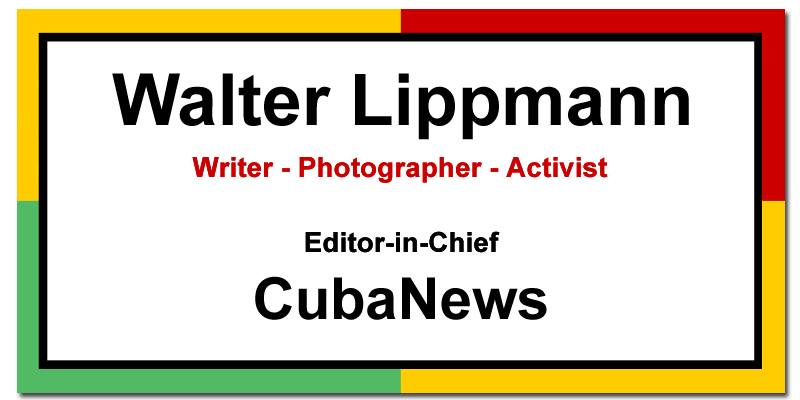
You must be logged in to post a comment.